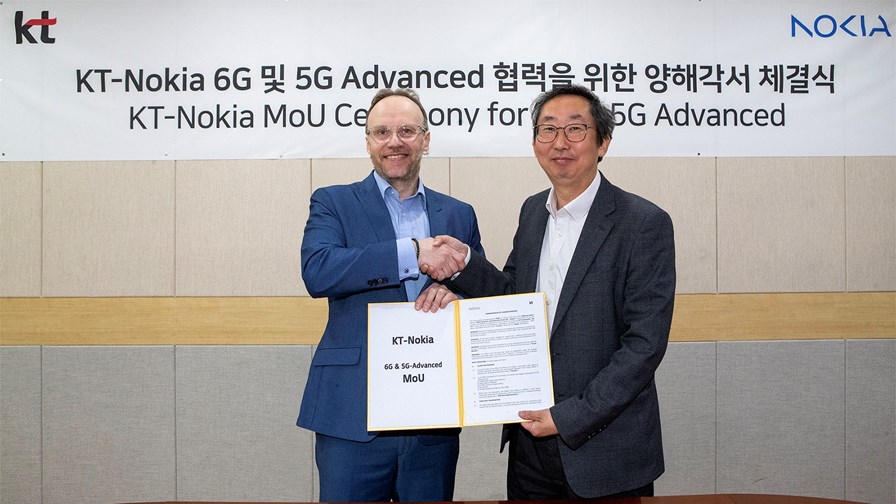
KT and Nokia sign an agreement for global research cooperation on 6G.
- KT has been actively exploring the potential of 6G
- It is now partnering with Nokia to beef up its research efforts and to secure a leading role in the next-generation era
- Other major telcos are also looking at 6G innovation
- But while certain operators are very focused on 6G, it’s a term that is off-putting to others
South Korean telco KT has announced it it partnering with Nokia for 6G research, in a sign that major players in the vendor and operator community are still looking to get ahead of their peers and rivals in relation to the next generation of cellular technology. It also comes as a reminder that, despite some negative sentiment in the industry, the 6G term is being fully embraced by many.
In a translated statement, KT noted that its agreement with the Finnish vendor will result in the two companies developing advanced Open RAN technology for 6G, which is expected to be deployed by many operators in around 2030. They will also work on ultra-broadband wireless access technology using candidate 6G frequencies, and hope to identify future services that will be relevant to the 6G era.
Through this collaboration, KT aims to secure a global leading position in the establishment and the commercialisation of standards for 6G. Lee Jong-sik, managing director of KT Network Research Institute, stated that KT expects its partnership with Nokia to enable it to “lead the development of mobile communication technology directly connected to future cloud and AI.”
Ari Kinaslati, VP of Nokia Wireless Strategic Technology, concurred, adding that the two companies share a goal of securing “technological superiority between KT and Nokia through joint research”.
This is not the first effort by KT to spearhead innovation in the future mobile communications era: In October 2023, KT joined forces with LG Electronics and Corning for the development and the verification of a reconfigurable intelligent surface (RIS) that “operates in each 6G frequency candidate band”.
Currently, global technology standards organisations the International Telecommunication Union (ITU) and 3GPP (a consortium of seven telecoms standards organisations) are working on the framework, the frequency and the overall vision for 6G. ITU is aiming to produce a final set of 6G technology standards by 2030, while 3GPP is preparing for the transition to 6G standardisation this year and plans to complete the standard specifications (Release 21), required for 6G commercial network development, by 2029.
What’s in a name?
The technical reference for 6G, ‘IMT-2030’, was adopted by the ITU in November 2023 (which also marked the initial phase that sets the basis for the development of IMT-2030). Since then, however, it has referred to the future communication standard as ‘6G’, as it is more commonly known.
Meanwhile, the term ‘6G’ was granted an approved logo by 3GPP last month. The trademark is set to be used on specifications for 6G.
The term has been broadly used across the industry for years already, even while 5G has stuttered. In one example from KT’s domestic market, its rival SK Telecom (SKT) last year outlined several ‘megatrends’ for the upcoming generation of wireless connectivity – see SK Telecom highlights three ‘megatrends’ for the 6G era.
In Europe, some organisations are also keen to use the term, as well as to boost innovation efforts. Towards the end of 2023, European Union body the Smart Networks and Services Joint Undertaking (SNS JU) awarded €130m to 27 new research, innovation and trial projects, which will “support and accelerate ground-breaking research in 6G technologies throughout Europe and beyond.”
Contrary to this, others are not as eager to think about another ‘G’ in the mobile connectivity evolution. Orange chief technology and innovation officer (CTIO) Bruno Zerbib used a briefing session at this year’s Mobile World Congress in Barcelona to stress that the telco industry needs to move away from generational developments. At the time, he suggested that the sector can focus on ongoing innovation and adding new capabilities now instead of waiting for these functionalities to be put in a frame as 6G standardisation comes along – see Orange CTIO: It’s time to embrace continuous innovation.
Others would like to see an end to the G cycle altogether – see An F for the Gs: 5G discontent surfaces for 2023.
But the 6G force is strong and as the years count down towards 2030, expect to hear an awful lot more about how the industry plans to learn from its 5G shortcomings and make 6G a success.
- Yanitsa Boyadzhieva, Deputy Editor, TelecomTV
Email Newsletters
Sign up to receive TelecomTV's top news and videos, plus exclusive subscriber-only content direct to your inbox.




